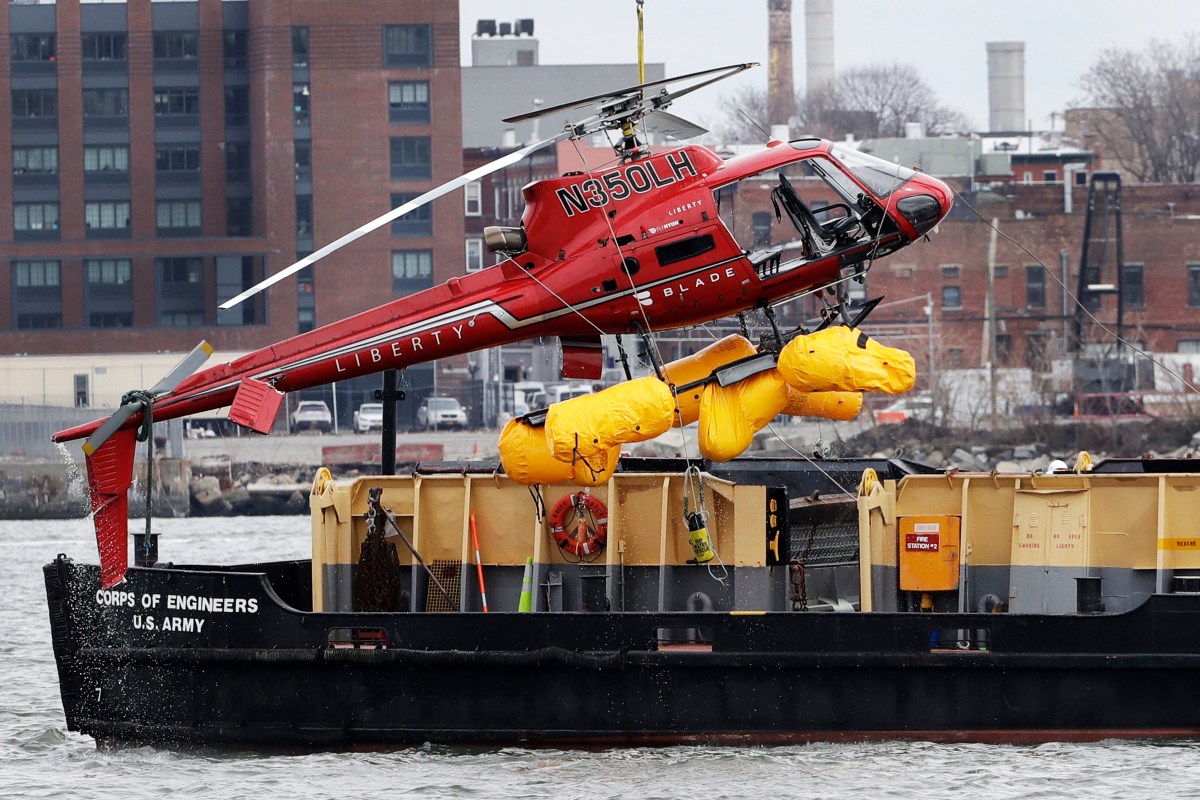BY MICHAEL R. SISAK
The helicopter company whose doors-off flight crashed in a New York City river last year, trapping all five passengers in their harnesses, exploited a regulatory loophole to avoid stricter safety requirements, federal investigators said Tuesday.
FlyNYON operated under the government’s least stringent standards “to the detriment of their customer’s safety” because it described the purpose of its flights as photography, not sightseeing, National Transportation Safety Board Chairman Robert Sumwalt said.
The company went so far as to instruct employees to avoid using terms like “air tour” or “sightseeing” to avoid losing its certification under a photography exception that allowed it to fly under the same regulations as private pilots and hobbyists, investigators said.
“This is a loophole that one could fly a helicopter or drive a truck through,” NTSB Vice Chairman Bruce Landsberg said at a hearing on the crash at the board’s headquarters in Washington.
NTSB member Jennifer Homendy called it “an egregious interpretation of current regulations.”
The Federal Aviation Administration told the board that the decades-old exemption was meant for things like newsgathering, surveying, commercial photography and film shoots — not personal entertainment or leisure purposes like sightseeing tours.
Those kinds of flights that buzz around Manhattan, the Grand Canyon and other tourist spots are normally subjected to stringent commercial aviation standards, including FAA-approved training, maintenance and drug and alcohol programs.
Despite its caginess with regulators, FlyNYON on its website promotes “sneaker selfies,” complete with video of a passenger’s feet dangling over lower Manhattan, and boasts of having flown more than 250,000 passengers.
The crashed helicopter was on such a flight when it ended up in the chilly East River in March 2018 after a tether meant to keep a passenger from falling out got caught on a fuel shutoff switch, stopping the engine minutes into the scheduled 30-minute flight.
In submissions to the board, FlyNYON faulted the design of the Eurocopter AS350’s floor-mounted fuel controls and its emergency flotation system, which failed to fully inflate and keep the aircraft from flipping over and sinking.
The manufacturer of the flotation system, DART Aerospace, said in a written submission to investigators that pilot Richard Vance likely failed to fully pull the inflation lever, leaving the flotation devices only partially inflated.
The NTSB cited those issues at its hearing Tuesday, but put most blame for the drowning deaths of all five passengers on FlyNYON and the hard-to-escape harness system that it installed on top of federally mandated restraints.
The crash was survivable if not for the passenger-trapping harnesses, the board said. It recommended that the FAA ban supplemental restraint systems until the agency can get a handle on regulating them.
In addition to a lap belt and upper body restraint installed by the helicopter manufacturer, FlyNYON provided passengers on the doomed flight with a nylon fall-protection harness that could be released only by cutting a tether with a provided knife or unscrewing a locking carabiner at their backs, investigators said.
“The contraption that FlyNYON rigged up turned a perfectly good helicopter into a death trap,” Sumwalt said. “That is a fact.”
The board also slammed the safety culture at FlyNYON, which arranged the flight, and Liberty Helicopters, the company that FlyNYON contracted with for helicopters and pilots. FlyNYON’s CEO stressed profits over safety and remarked that pilots who complained “can’t get their snowflake feelings hurt,” according to Homendy.
In a statement, FlyNYON said safety has always been its “first priority and we have made changes to our operations to help ensure an accident like this never happens again.”
FlyNYON said it now operates its own fleet of Bell 206 helicopters with its own pilots. Liberty declined to comment, saying the crash remains subject to active litigation.
Video from a GoPro camera mounted in the cabin of the doomed helicopter shows passengers struggling to free themselves from the tight harnesses — akin to something a construction worker would buy at Home Depot — as the aircraft fills with water, investigators said.
“How do I cut this?” one passenger asks, according to a transcript of the video, just 13 seconds before the helicopter becomes completely submerged.
A passenger is seen on the video reaching for a spot on his chest where a hook knife had been earlier, investigators said. Another pulls in vain at the shoulder straps of his harness, and another is heard panting.
Police and fire department divers said they found their bodies strapped in harnesses and used knives to cut them loose. Visibility underwater was maybe a foot, divers told investigators.
The FAA grounded doors-off flights after the crash, but they have since resumed, with the agency requiring restraints that can be released with just a single action in an emergency.
After the crash, the FAA started inspecting supplemental passenger restraint systems, but the NTSB said Tuesday that the agency hasn’t provided adequate guidance to inspectors.
A message was left with the FAA seeking comment.
On its website, FlyNYON says it now uses an FAA-approved, industry-tested quick-release harness system on all doors-off flights, allowing “fast and simple exit in case of an emergency.”
Vance, the pilot, was wearing just a seat belt and was able to free himself, officials said. Asked by investigators whether he considered going back to rescue the passengers, Vance said that he wanted to, but that he thought his clothing would weigh him down.
The passengers who died were Dallas fire Officer Brian McDaniel, 26; his friend Trevor Cadigan, 26, a journalist from Dallas who had recently moved to New York; Carla Vallejos Blanco, 29, a tourist from Corrientes, Argentina; Tristan Hill, 29, who for a time was a basketball operations assistant with the Westchester Knicks, a Development League affiliate of the New York Knicks; and Daniel Thompson, 34.
































